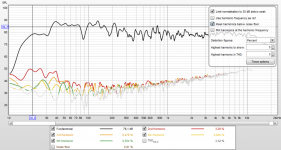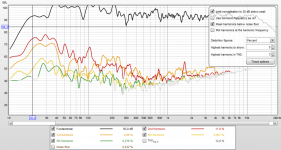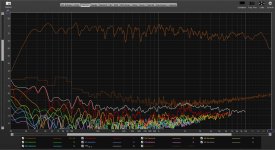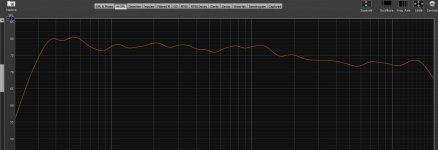Measuremt is made for THD but presented is only noise floor. Remove "Mask harmonics below noise floor" option, then somthing meanigful can be seen.
Hey,Experimental OB project, sounds good to my ears...
I looked back through your post's bat can't find any build info. Can you tell us about it?
Jeremy
von Ah's measurements spl is around 75dB. All distortion lines go below noise floor and are thus irrelevant nonsense. 90-95dB will do.
But spl of the pure signal looks very good! I would attenuate everything above 200Hz about 5dB and low treble 1.5-4dB too. Using 1/2 oct smoothing helps to evaluate tonality.
But spl of the pure signal looks very good! I would attenuate everything above 200Hz about 5dB and low treble 1.5-4dB too. Using 1/2 oct smoothing helps to evaluate tonality.
Hi Jeremy
Active with DCX2496 ( modded) and Raspberry PI3 with Hifiberry Digi + pro as musicsource with Flac files. 6 cannels controled by Yamaha RX-V 3800 in multichannel mode and extra a modded Kenwood Basic M2 for the bass units.
I have build 2 disub subwoofers, cut off at 120 hz, each one of them with 2 peerless 12 inch woofers, more or less copied from W type linkwitz woofercabinets, made the baffles of plain multiplex boards wit Hivi Research 5 inch midwoofers,cut off at 2800 hz , 2 each and Neo 8S as high units, so open at the back, with DCX2496 reasonable flat till 12000 hz, above that I do not hear anything, so no need to extend the flat line...too old..lol.
Cheers, Tojoko.
Active with DCX2496 ( modded) and Raspberry PI3 with Hifiberry Digi + pro as musicsource with Flac files. 6 cannels controled by Yamaha RX-V 3800 in multichannel mode and extra a modded Kenwood Basic M2 for the bass units.
I have build 2 disub subwoofers, cut off at 120 hz, each one of them with 2 peerless 12 inch woofers, more or less copied from W type linkwitz woofercabinets, made the baffles of plain multiplex boards wit Hivi Research 5 inch midwoofers,cut off at 2800 hz , 2 each and Neo 8S as high units, so open at the back, with DCX2496 reasonable flat till 12000 hz, above that I do not hear anything, so no need to extend the flat line...too old..lol.
Cheers, Tojoko.
Thanks, @Juhazi . A little more tweaking today, and here is where I have it. 1/2 smoothing for tonality.
Sounds VERY good.
Sounds VERY good.
Attachments
REW can measure THD below noise floor, it is relevant. Probably SPL level is not calibrated and can actually be some other number.von Ah's measurements spl is around 75dB. All distortion lines go below noise floor and are thus irrelevant nonsense. 90-95dB will do.
kaamelis, do you really see anything relevant in mentioned distortion measurement? Please don't encourage people to use poor methods!
A loudspeaker's distortion typically has high numbers below 100Hz and some peaks above it. Room noise is typically also high below 100Hz and then rather smooth around 40dB but has also some peaks from eg. fridge, air conditioning etc.
REW masks distortion (makes lines grey) below noise floor by defaut settings, because of these problems. (Earlier versions didn't have this masking feature. Noise floor wasn't defined either some years ago)
Here same speaker measured with low and high spl. Indoor distortion measurement of a loudspeaker is always unreliable! With high spl room and furniture makes resonances too.


A loudspeaker's distortion typically has high numbers below 100Hz and some peaks above it. Room noise is typically also high below 100Hz and then rather smooth around 40dB but has also some peaks from eg. fridge, air conditioning etc.
REW masks distortion (makes lines grey) below noise floor by defaut settings, because of these problems. (Earlier versions didn't have this masking feature. Noise floor wasn't defined either some years ago)
Here same speaker measured with low and high spl. Indoor distortion measurement of a loudspeaker is always unreliable! With high spl room and furniture makes resonances too.


Finished today, after about 5 months development... they sound great, I'm really happy 



Excellent job! I'll bet they sound as good as they look. When you have the chance, list the driver compliment and the xover components (schematic, slope & freq. data too).
Many thanks! You can find the data here: https://www.diyaudio.com/community/threads/my-open-baffle-journey.394806/post-7243560 framed in a "short" story😀
I’ve been enjoying my DSP 3-way OB creations very much for several weeks. I know I could just continue to tweak and refine from here ad-nauseam, but I’m interested in the possibilities of hybrid analog crossover plus DSP tweaking. Simplicity for amplification is temping if I can get an analog crossover “close enough” such that the full frequency response of the system can be tweaked with my MiniDSP Flex Eight. Granted, I love using THREE of my DIY amps all at once in the main system, but periodically switching out components (part of the fun of this hobby) is nearly completely halted by the complexity.
So, have others gone through a similar exploration? Is it a fool’s errand to try for a 3-way OB analog crossover (with no expertise) when DSP is comparatively much easier? Am I just being a brat? 😊
So, have others gone through a similar exploration? Is it a fool’s errand to try for a 3-way OB analog crossover (with no expertise) when DSP is comparatively much easier? Am I just being a brat? 😊
I use hybrid crossover in 2-way horns/open baffle speakers (and active crossover with subs in my amp) with passive crossover and 15db of overall EQ. For me, it works great. And I didn't have the expertise at the start, but with practice, you get some experience, its interesting and fun.So, have others gone through a similar exploration? Is it a fool’s errand to try for a 3-way OB analog crossover (with no expertise) when DSP is comparatively much easier? Am I just being a brat? 😊
Thanks Nicoh!Nice Plott , maybe can have a more balance bass with 12 under and alpha up....
"More balanced bass" - compared to what? 🙂
In fact I like the bass as is. You wrote this recommendation earlier and I made a trial with the SB in lower position, but - at least in this config - the bass was weaker.
IMO the advantages of DSP and mulitchannel amps far out way the complexity. For one each amplifier only has to deal with a limited bandwidth so non-linear distortion is potentially reduced. A speaker level XO in an OB can be a difficult beast to design and get the best out of it due to the varying load impedance with frequency it presents to the amplifier as well as only having the ability to attenuate peaks in response where DSP can be used to attenuate and boost to flatten frequency response.I’ve been enjoying my DSP 3-way OB creations very much for several weeks. I know I could just continue to tweak and refine from here ad-nauseam, but I’m interested in the possibilities of hybrid analog crossover plus DSP tweaking. Simplicity for amplification is temping if I can get an analog crossover “close enough” such that the full frequency response of the system can be tweaked with my MiniDSP Flex Eight. Granted, I love using THREE of my DIY amps all at once in the main system, but periodically switching out components (part of the fun of this hobby) is nearly completely halted by the complexity.
So, have others gone through a similar exploration? Is it a fool’s errand to try for a 3-way OB analog crossover (with no expertise) when DSP is comparatively much easier? Am I just being a brat? 😊
I did this years ago before DSP was readily available, Now I have DSP I wouldn't bother going back. Also all DSP's are not crerated equal, I was running my 4way OB build with a modified MiniDSP 4x10HD before switching to an Analog Precision AP2 preamp which has 8 DSP channels. The AP is in another league to the MiniDSP.
I believe I invented a new type of speaker enclosure:
Open Baffle+Reflex Hybrid w/ Single Woofer
The upper half of the woofer is dipole; the lower half is reflex, and the space between the divider and the woofer cone serves as the port.
I opened a new discussion thread with full details here: https://www.diyaudio.com/community/...en-back-reflex-hybrid-w-single-woofer.396877/
Open Baffle+Reflex Hybrid w/ Single Woofer
The upper half of the woofer is dipole; the lower half is reflex, and the space between the divider and the woofer cone serves as the port.
I opened a new discussion thread with full details here: https://www.diyaudio.com/community/...en-back-reflex-hybrid-w-single-woofer.396877/
Last edited by a moderator:
Could you tell us more about your speakers - I’m also planning an OB / horn hybrid: OB bass / mid up to c. 600hz crossing over to a hornI use hybrid crossover in 2-way horns/open baffle speakers (and active crossover with subs in my amp) with passive crossover and 15db of overall EQ. For me, it works great. And I didn't have the expertise at the start, but with practice, you get some experience, its interesting and fun.
- Home
- Loudspeakers
- Multi-Way
- Ultimate Open Baffle Gallery

